Abstract
The Karamaili Granite Belt (KGB) in the southern margin of the Eastern Junggar is the most important tin metallogenic belt in the southwestern Central Asian Orogenic Belt. The plutons in the western part have a close genetic relationship with tin mineralization. The zircon U-Pb ages of the Kamusite, Laoyaquan, and Beilekuduke plutons are 315.1 ± 3.4 Ma, 313.6 ± 2.9 Ma, and 316.5 ± 4.6 Ma, respectively. The plutons have high silica (SiO2 = 75.53%–77.85%), potassium (K2O = 4.43%–5.42%), and alkalis (K2O + Na2O = 8.17%–8.90%) contents and low ferroan (Fe2O3T = 0.90%–1.48%), calcium, and magnesium contents and are classified as metaluminous–peraluminous, high-potassium, calc-alkaline iron granite. The rocks are enriched in Rb, Th, U, K, Pb, and Sn and strongly depleted in Ba, Sr, P, Eu, and Ti. They have strongly negative Eu anomalies (δEu = 0.01–0.05), 10,000 Ga/Al = 2.87–4.91 (>2.6), showing the geochemical characteristics of A-type granite. The zircon U/Pb ratios indicate that the above granites should be I- or A-type granite, which is generally formed under high-temperature (768–843 °C), low-pressure, and reducing magma conditions. The high Rb/Sr ratio (a mean of 48 > 1.2) and low K/Rb ratio (53.93–169.94) indicate that the tin-bearing plutons have undergone high differentiation. The positive whole-rock εNd(t) values (3.99–5.54) and the relatively young Nd T2DM model ages (616–455 Ma) suggest the magma is derived from partially melted juvenile crust, and the underplating of basic magma containing mantle materials that affected the source area. The results indicate the KGB was formed in the tectonic transition period in the late Carboniferous subduction post-collision environment. Orogenic compression influenced the tin-bearing plutons in the western part of the KGB, forming highly differentiated and reduced I, A-type transition granite. An extensional environment affected the plutons in the eastern sections, creating A-type granite with dark enclaves that suggest magma mixing with little evidence of tin mineralization.
1. Introduction
The Central Asian Orogenic Belt (CAOB) is located between the Siberian, Eastern European, and the Tarim-North China plates. It is the largest Phanerozoic accretionary orogenic belt in the world. It was formed by the collage and convergence of various tectonic units during the closure of the Paleo-Asian Ocean from the Neoproterozoic to the Late Paleozoic [1,2,3,4]. The Eastern Junggar orogenic belt is located in the southwestern part of the CAOB. It is an important tectonic unit in its central belt and contains information on the tectonic evolution and mineralization of the CAOB [5,6,7]. It is believed that the tectonic evolution of the Eastern Junggar region occurred from the beginning of the Middle Cambrian to the end of the Permian [3]. Some scholars believe that the subduction of the Karamaili ocean basin and the Irtysh-South Mongolia ocean began in the early Devonian and ending in the middle and late Permian [8]. Others have suggested that a two-way subduction of the Junggar Ocean began in the early Carboniferous, closing the late Carboniferous ocean, and ended in the early Permian [9]. These different interpretations point to the late Paleozoic collisional tectonic framework as an important period of orogenic evolution in Eastern Junggar.
Due to the subduction and closure of the ancient Junggar Ocean in the early Carboniferous, the entire Eastern Junggar region experienced strong tectonic-magmatic-thermal events, forming extensive A-type granites and volcanic rocks. The Karamaili Granite Belt (KGB) at the southernmost margin of Eastern Junggar is the most significant among them [9]. The KGB is dominated by A-type granites, and some have I-A-type transitional characteristics. They were formed by magmatic events in the post-collisional environment of the late Carboniferous-Permian [10]. Analyses of massive granite belts provide critical information for plate subduction, collision, post-collision orogenic processes, and formation of deposits [11] and a basis for understanding crust–mantle interactions and metallogenic settings [12,13]. Most global tin deposits are found in areas of S-type granites, whereas relatively few are related to A-type granites [14,15]. Several tin deposits have been found in areas of A-type granites in the western part of the KGB in Eastern Junggar, including the Kamusite, Ganliangzi, and Beilekuduke deposits [16]. These represent the only tin mineralization areas related to A-type granite in the CAOB [17]. Although there are abundant granite types in the KGB, tin mineralization is only closely related to some granites in the western KGB [18]. They are located in the western plutons, such as the Kamusite, Laoyaquan, and Beilekuduke plutons, suggesting that magma evolution affected the tin mineralization of these greisen and quartz vein types. However, the plutons in the eastern KGB contain a large number of dark enclaves, and the alkaline granite with a low degree of differentiation is often closely related to gold and graphite minerals. The overall reflection shows that the magmatic activity of the KGB has obvious spatial differences. Therefore, it is crucial to conduct a systematic analysis of the magmatic conditions, evolution, and time of formation of the tin-bearing pluton in the KGB to obtain insights into the tectonic evolution and mineralization in the Eastern Junggar [5].
Scholars have conducted extensive research on the intrusion and tin mineralization age of granites in the western part of the KGB. For example, the intrusion age of the Kamusite pluton is from 292 ± 7 Ma to 324.8 ± 2.7 Ma [10,19,20], and the tin mineralization age is 307 ± 1 Ma [21]. The intrusion age of the Laoyaquan pluton ranges from 302.15 ± 2.8 Ma to 317.6 ± 3.3 Ma [22,23,24,25], with a tin mineralization age of 305 ± 25–314 ± 1 Ma [26,27]. The intrusion age of the Beilekuduke pluton is from 302.15 ± 2.8 Ma to 317.6 ± 3.3 Ma [28,29], and the mineralization age is 264 ± 3–305 ± 1 Ma [21,27,30]. The predecessors believed that the tin mineralization of the above granites is the evidence of mineralization of oceanic ridge subduction in Eastern Junggar [31]. Although researchers have investigated the western plutons in the KGB, a lack of research exists on the newly discovered mineralized area and the systematic comparison with the eastern plutons. Therefore, we have studied the petrography, geochemistry, zircon U-Pb geochronology, and Nd isotopes of the new mineralized area of tin-bearing plutons. The objectives are to determine the duration of magmatic activity, petrogenesis, magmatic source, magmatic conditions, and tectonic evolution of tin-bearing plutons in the western KGB. The relationship between magmatic evolution and tin mineralization is discussed. It provides crucial magmatic information on tin mineralization in the KGB and facilitates tin mineral exploration.
2. Regional Geological Background
The Eastern Junggar is located in the southwestern part of the CAOB between the Siberian plate and the Junggar plate. It is bounded by the Irtysh-Mayinebo fault zone in the north (Figure 1a), the Ulungur fault zone in the central part, and the Karamaili-Moqinwula fault zone in the south. Its regional tectonic trend is NW-SE. It is a critical tectonic unit in the southwestern part of the CAOB [9,32,33]. Three major granite belts and three NW-trending ophiolite belts formed in the post-collisional extensional environment (Figure 1b). From north to south, they include the Dalabute, Zhaheba-Almantai, and Karamaili ophiolite belts [3,34]. The Eastern Junggar has experienced a long and complex tectonic evolution since the Precambrian period. It has a highly complex tectonic setting and very strong magmatic activity. The late Paleozoic was the peak of magmatic activity and mineralization in the Eastern Junggar, representing a critical period for the formation and evolution of the ancient Junggar ocean basin and the transformation of the tectonic system [10,35,36]. The magmatic rocks are diverse and include acidic, dioritic, ultrabasic, basic, and alkaline rocks. Due to the strong magmatic activity in the late Paleozoic, multi-stage mineralization occurs, resulting in diverse deposits, such as porphyry copper (gold) deposits, magmatic copper–nickel deposits, skarn copper, iron ore, orogenic gold deposits, quartz vein–greisen tin deposits, late magmatic chromite, and volcanic rock gold deposits [37].
The KGB is located at the southern margin of the Eastern Junggar orogenic belt [38,39]. The tuffaceous siltstone and pyroclastic rocks from the Devonian and Carboniferous are exposed on the south and north sides of the KGB (Figure 1c). The famous Karamaili ophiolitic mélange belt runs parallel to the south side. The KGB is an extension of the edge of the Junggar terrane and is a NW-trending belt with a length of about 110 km and an exposed area of about 1100 km2 [20,40]. The KGB consists of the Kamusite, Laoyaquan, Beilekuduke, Sabei, Huangyangshan, and Sujiquan plutons from the northwest to the southeast [28,41]. The coordinates of the area are 89°24′39.95′′ E, 45°23′3.50′′ N–90°32′46.17′′ E, 44°59′23.63′′ N. The KGB was formed by a post-collisional magmatic event 330–280 Ma ago in the late Paleozoic [10]. It is the largest granite belt in the Eastern Junggar and consists of A-type granite [40,42,43,44]. It is an important tin metallogenic belt in Xinjiang [19,23,28,45,46]. Gold, graphite, and copper deposits occur in the eastern Sabei, Huangyangshan, and Sujiquan plutons [40,47]. In contrast, the Kamusite, Laoyaquan, and Beilekuduke plutons in the western section contain tin deposits, such as the Kamusite, Ganliangzi, and Beilekuduke deposits [18,43]. These tin deposits include quartz veins, greisen, and altered granite types; the first two are dominant. The shape of the ore deposits is primarily veined, irregular, and beaded, but a lenticular shape also occurs. Several ore bodies in the Kamusite tin deposit are found in groups oriented in a near SN direction [40]. The width of a single vein ranges from 20 cm to 5 m, and the length is about 100 m. The vein group of the Ganliangzi tin deposit is NE-trending, and a single vein is generally 50–200 m long and 0.5–10 m wide [18,43]. The vein group of the Beilekuduke tin deposit is NE-trending; the length of a single vein is about 60 m, and the width is 1–5 m. Greisenization, potassic alteration, and kaolinization are observed, and the alteration has occurred on both sides of the ore body [28,29]. The level of alteration decreases from the center. Generally, no boundary exists between the surrounding rock and the altered rock, and the transition is gradual [17].
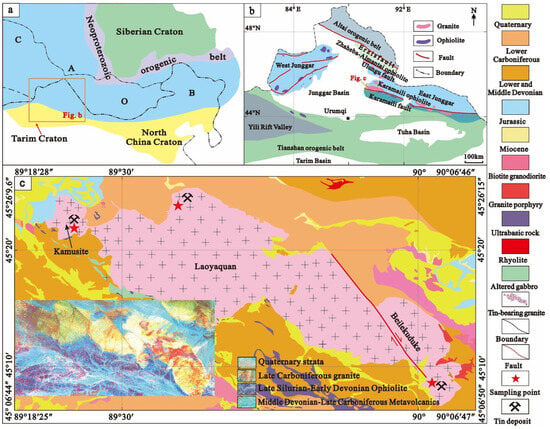
Figure 1.
(a) Geological sketch of the CAOB (revised from [44]). (b) The geological map of the northern region of Xinjiang (revised from [44]). (c) Regional geological map of the tin-bearing pluton at the western end of Karamaili (revised from [48]).
3. Petrographic Characteristics
The Kamusite pluton is located at the westernmost end of the KGB. It is nearly equi-dimensional on the surface, with an exposed area of about 30 km2. The north side of the pluton is bounded by the Jurassic strata, and the south side invades the Devonian strata. The exposed strata are primarily tuffaceous siltstone and pyroclastic rocks from the Devonian and Carboniferous. The rock type is predominantly potassium feldspar granite. It is light red and has an uneven, inequigranular texture. It is composed of K-feldspar (50%–60%), plagioclase (10%–15%), quartz (20%–35%), and biotite (3%–5%) (Figure 2b,c). The potassium feldspar is anhedral granular and contains perthitic exsolutions. Quartz has wavy extinction, is transparent or grayish white, and granular in shape. Biotite has parallel extinction, and flake distribution in granite. The accessory minerals are apatite, zircon, and magnetite, among others.
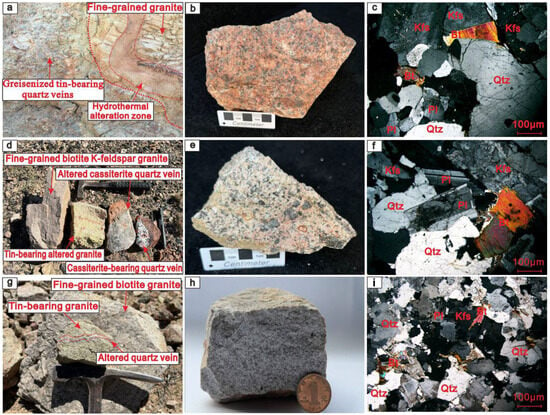
Figure 2.
Field photographs of the KGB (a,d,g) and photographs of hand specimens (b,e,h) and microstructure photographs (c,f,i).
The Laoyaquan pluton is the largest pluton in the KGB, with an exposed area of 673 km2. It has intruded into the Carboniferous Kamusite Formation, and the long axis is nearly parallel to the Karamaili suture zone. The north side of the pluton extends into the Carboniferous strata, and the south side extends into the Devonian strata. The newly discovered tin deposit is located in the northeast of the pluton (Figure 1c). Several tin-bearing quartz veins are developed in the NE-trending fault zone at the edge of the K-feldspar granite. The cassiterite is distributed in fine-grained disseminated form, and the greisenization is relatively strong (Figure 2a), with local fluoritization. The length of each ore body is about 10–100 m, and the pulse width is between 50 cm–2 m. The wall rock of the mining area is strongly altered, and the alteration zoning of the deposit is characterized by fine-grained biotite K-feldspar granite→tin-containing altered granite→altered tin-quartz vein→tin-containing quartz vein (Figure 2d). The rock type is primarily biotite K-feldspar granite. It is light red and has a medium-coarse grain structure. It consists of quartz (30%–35%), alkali feldspar (20%–30%), plagioclase (10%–15%), and biotite (7%–10%) (Figure 2e,f). The alkali feldspar is comprised of potassium feldspar with a perthitic exsolution lamellae structure. Additional minerals include zircon, fluorite, apatite, and others.
The Beilekuduke pluton has intruded into the Devonian clastic rock stratum in the form of a rock plant. The pluton is controlled by the northwest strike-slip fault zone and spreads along the northwest direction, with an exposed area of about 25 km2. The surrounding rock of the mining area exhibits quartz vein alteration with the following characteristics: fine-grained biotite granite→tin-bearing granite→altered quartz vein (Figure 2g). The rock type is primarily biotite granite. It is light gray to white and has a medium-fine-grained structure. It consists of alkali feldspar (30%–35%), quartz (25%–35%), plagioclase (10%–20%), and biotite (5%) (Figure 2g–i). The alkali feldspar is potassium feldspar with exsolution lamellae and Carlsbad twinning. The quartz is grayish-white and granular. The biotite exhibits parallel extinction and is flaky. Additional minerals include zircon, magnetite, and others. The phenocrysts are mainly potassium feldspar and quartz, and the matrix composition is similar to the phenocrysts but is microcrystalline and cryptocrystalline.
4. Sample Collection and Analytical Methods
We collected 14 samples from different plutons. The samples were fresh and exhibited no granite alteration. They included 6 samples of the Kamusite pluton, 4 samples of the Laoyaquan pluton, and 4 samples of the Beilekuduke pluton. The 14 samples were sent to the Beijing Yanduzhongshi Testing Technology Co., Ltd (Beijing, China). to perform whole-rock major and trace element analysis. One sample was selected from each pluton for zircon U–Pb dating. The sample locations are shown in Figure 1.
The major elements were determined by fusion X-ray fluorescence (XRF) spectrometry (GB/T 14506. 28-2010) using a Shimadzu XRF-1800 wavelength dispersive XRF spectrometer(Shimadzu, Kyoto, Japan). The rock was crushed to centimeter-level blocks, and fresh samples without alteration or veins were selected and washed with purified water, dried, and crushed to 200 mesh. The powdered sample was weighed, mixed with Li2B4O7 (1:8) flux, and heated to 1150 °C in a gold–platinum crucible using a melting machine to transform it into a uniform glass sheet. XRF spectrometry was performed using a Zetium PANalytical or Shimadzu XRF-1800 instrument. The analytical error of the major element analysis was within 1%. The trace element analysis was conducted using digestion of the pretreated silicate powder samples (200 mesh). Inductively coupled plasma mass spectrometry (ICP-MS) was conducted using an Analytic Jena Plasma Quant mass spectrometer. The error of the measured data was less than 5%, and the analysis error of volatile and very-low-content elements was less than 10%. The test results are listed in Table 1.

Table 1.
Analytical results of major element oxides (%), and trace elements (10−6), including rare earth elements of the western KGB.
The laser ablation-ICP-MS (LA-ICP-MS) and zircon U-Pb isotope analysis was performed at the Beijing Yanduzhongshi Testing Technology Laboratory. The zircons used for dating were selected under a binocular microscope to choose clean and transparent ones with good crystal shapes and no inclusions or cracks. They were attached to the epoxy resin target, and the exposed interior was polished. The reflectance and cathodoluminescence (CL) analysis was conducted using crystals with no surface cracks or rings. The analytical instrument was a Jena M90 LA-ICP-MS mass spectrometer (Analytik Jena GmbH, Jena, Germany). The U-Pb isotopic age and trace element content of the zircons were determined using a UP213 (laser 213 nm) deep ultraviolet laser ablation system and a Jena M90 ICP-MS instrument. The diameter of the spot beam used for ablation was 20–30 μm, the frequency was 10 Hz, and the energy density was 2.5 J/cm2. Helium was used as the carrier gas of the ablation material. Data processing and plotting of the U-Pb concordant diagram were performed with Isoplot (Version 3.7). The error of a single data point is quoted as 1σ, the age was the concordant age, and the weighted average has a 95% confidence interval. The analytical conditions and procedures have been described by [20]. The results are listed in Table 2.

Table 2.
Analytical results of LA-ICP-MS zircon U-Pb granite of the KGB.
Six whole-rocks were selected for Nd isotope analysis. The REE solution from the Sr-column method was evaporated to incipient dryness and taken up with 0.18 M HCl. The converted REE solution was loaded into an ion-exchange column packed with LN resin. After the complete draining of the sample solution, the columns were rinsed with 18 mL of 0.18 M HCl to remove undesirable matrix elements. Finally, the Nd fraction was eluted using 5 mL of 0.3 M HCl and gently evaporated to dryness prior to mass spectrometric measurement. Nd isotope analyses were performed on a Neptune Plus MC-ICP-MS (Thermo Fisher Scientific, Dreieich, Germany), as equipped with nine Faraday cups. An aliquot of the standard solution of 200 μg L−1 GSB 04-3258-2015, which was regularly used for evaluating the reproducibility and accuracy of the instrument. Typically, the signal intensities of 142 Nd+ in GSB 04-3258-2015 were >~2.5 V. The Nd isotopic data were acquired in the static mode at low resolution. The routine data acquisition consisted of ten blocks of 10 cycles (4.194 s of integration time per cycle). All data reduction for the MC-ICP-MS analysis of Nd isotope ratios was conducted using “Iso-Compass” software [49]. One GSB 04-3258-2015 standard [50] was measured for every seven samples analyzed. Analyses of the GSB 04-3258-2015 standard yielded a 143 Nd/144 Nd ratio of 0.512440 ± 6 (2SD, n = 31), which is identical in error to their published values (0.512438 ± 6 (2SD) [50]).
5. Results
5.1. Geochemistry
The results of the major and trace element analysis of the 14 samples of K-feldspar granite (Kamusite pluton), biotite K-feldspar granite (Laoyaquan pluton), and biotite granite (Beilekuduke pluton) in the tin-bearing pluton group in the western section of the KGB are listed in Table 1. The major and trace elements compositions of the samples are highly similar. They have high silica (SiO2 = 75.53%–77.85%), potassium (K2O = 4.43%–5.42%), and alkali (K2O + Na2O = 8.17%–8.90%) contents, medium aluminum content (Al2O3 = 11.78%–12.72%), and low ferroan (Fe2O3T = 0.90%–1.48%), and calcium and magnesium (CaO = 0.08%–0.62%, MgO = 0.01%–0.19%) contents. These results indicate A-type, high-potassium, calc-alkaline granite (Figure 3a–c). The aluminum saturation indices (A/CNK) of the Kamusite and Laoyaquan plutons are 1.05–1.08 and 1.00–1.06, respectively, and the A/NK values are 1.06–1.12 and 1.10–1.12, respectively, indicating peraluminous rocks. The A/CNK range of the Beilekuduke pluton is 0.94–1.04, and the A/NK range is 1.01–1.12, suggesting quasi-aluminous to weakly peraluminous rock (Figure 3d). In the Harker diagram (Figure 4), the SiO2 content of the K-feldspar granite in the Kamusite pluton shows a significant negative correlation with Al2O3, K2O, Fe2O3T, and Na2O, and the relationship with MgO is unclear. The SiO2 content of the Laoyaquan pluton is negatively correlated with Al2O3, K2O, Fe2O3T, TiO2, and MgO, and a good positive relationship exists with Na2O. The SiO2 content of the Beilekuduke pluton is only negatively correlated with Fe2O3T, and is not related to the Na2O, Al2O3, K2O, TiO2, and MgO contents. Studies have shown that the initial magma temperature of granite can be obtained by using the saturation temperature of granite zircons. An analysis of captured/inherited zircons in the granite rocks indicates that the Zr content in the parent magma has reached saturation. The zircon saturation thermometers are 796–836 °C, 776–843 °C, and 792–833 °C, respectively, representing the upper limit of the initial magma temperature of the Kamusite, Laoyaquan, and Beilekuduke plutons [51,52]. They indicate a relatively high temperature of the magma system during zircon crystallization.
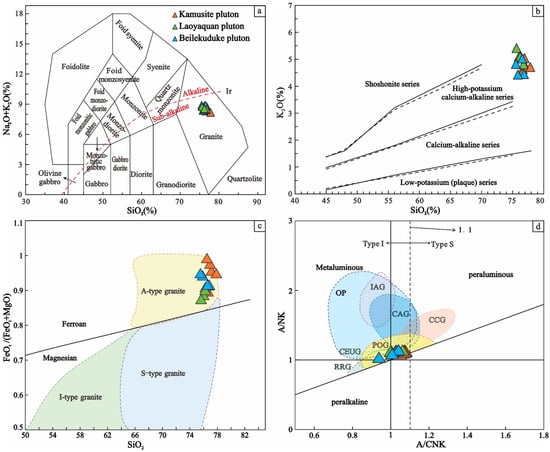
Figure 3.
(a) The total alkali–silica (TAS) of the tin-bearing granite in the KGB (revised from [53]). (b) Plot of K2O versus SiO2 (revised from [54]). (c) Plot of SiO2 vs. FeOT/(FeOT + MgO) (revised from [55]). (d) A/NK versus A/CNK (revised from [56]). Ir: Irvine’s series boundary.
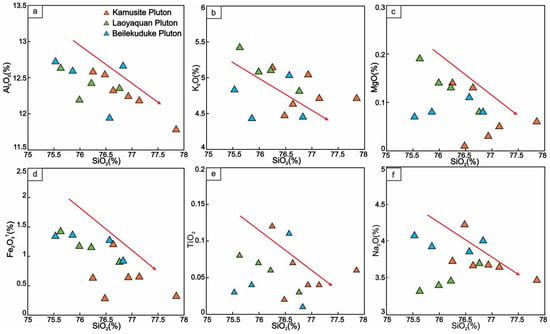
Figure 4.
Harker diagram of tin-bearing granites in the western KGB. (a) Plot of SiO2 vs. Al2O3. (b) Plot of SiO2 vs. K2O3. (c) Plot of SiO2 vs. MgO. (d) Plot of SiO2 vs. Fe2O3T. (e) Plot of SiO2 vs. TiO2. (f) Plot of SiO2 vs. Na2O.
The trace element contents are similar for the three granite types. The rare earth element (REE) and trace element distributions show concentrations (Figure 5a,b) indicating the same magma source area. The Kamusite, Laoyaquan, and Beilekuduke plutons have high contents of REEs (the ∑REE are 89.46 × 10−6–226.70 × 10−6, 109.10 × 10−6–224.81 × 10−6, and 97.12 × 10−6–198.3 × 10−6), and no differentiation of light REEs (LREEs) and heavy REEs (HREEs) is observed ((La/Yb)N: 0.36–3.53, 1.21–2.11, 0.66–1.89). No differentiation of LREEs and HREEs occurs (the (La/Sm)N is 0.89–2.58,0.85–2.95, and 1.03–2.74, the Gd/Yb)N is 0.25–1.13, 0.58–1.18, and 0.35–0.76, respectively). A strongly negative Eu anomaly is observed (the range of δEu is 0.01–0.05, 0.01–0.05, and 0.01–0.03, respectively), and the distribution of REEs has a flat V-shape (Figure 5a). The primitive mantle-normalized spider diagram of trace elements (Figure 5b) shows the three granite types to be enriched in Th, U, K, and other large ion lithophile elements and Pb, Nb, Ta, Hf, and Zr. The high field strength elements are not depleted or are slightly enriched, and strong depletion in Ba, Sr, P, Eu, and Ti occurs.
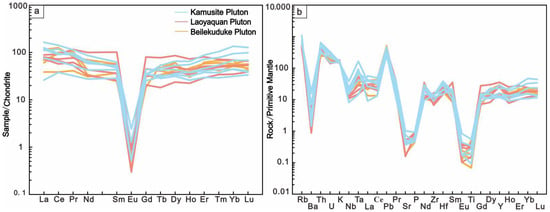
Figure 5.
(a) Chondrite-normalized REE patterns of the tin-bearing granite in the KGB. (b) Primitive mantle-normalized trace element spidergram of the tin-bearing granite in the KGB (normalization values from [57]).
5.2. Zircon U-Pb Geochronology
The zircon crystals in the three dated samples are colorless and transparent, euhedral–subhedral granular, and short columnar–long columnar. The CL images show oscillatory zoning. The grain size of the K-feldspar granite and biotite K-feldspar granite is 70–120 μm, whereas that of the biotite granite is 90–160 μm. The harmonic age values of the three samples are close to the weighted average age values (Figure 6), indicating that the U-Pb system remained closed after zircon formation, with no loss or addition of U or Pb. The analytical results are listed in Table 2.
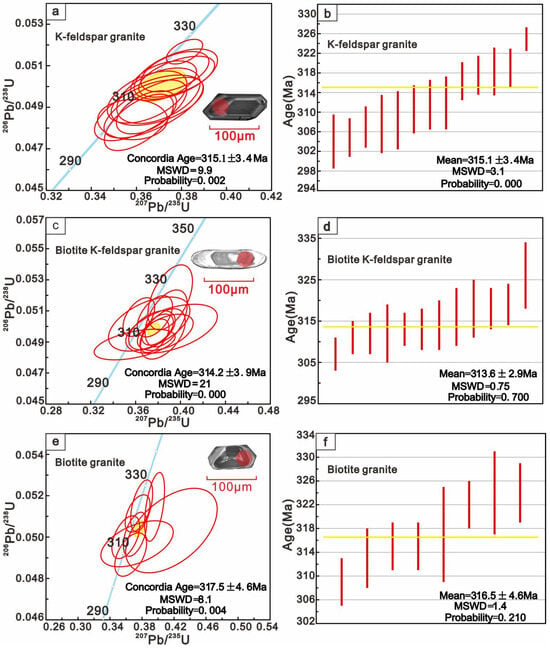
Figure 6.
CL images and U-Pb concordia diagrams of the zircons from the tin-bearing granite in the KGB (a–f).
The U, Th, and Pb contents of the zircons from of the K-feldspar granite (sample No. K1-1) in the Kamusite pluton are 98.16 × 10−6–934.25 × 10−6, 37.69 × 10−6–376.87 × 10−6, and 0.62 × 10−6–16.18 × 10−6, respectively, and Th/U is 0.38–0.609 (Table 2). The 13 concordant data points are located on or near the concordant curve. The concordant age is 315.1 ± 3.4 Ma (MSWD = 9.9) (Figure 6a), and the weighted average age is 315.1 ± 3.4 Ma (MSWD = 3.1) (Figure 6b).
The U, Th, and Pb contents of the zircons from the biotite K-feldspar granite (sample No. L1-2) in the Laoyaquan pluton are 82.88 × 10−6–1218.6 × 10−6, 35.53 × 10−6–281.14 × 10−6, and 0.58 × 10−6–5.99 × 10−6, respectively, and the Th/U ratio is 0.38–0.609 (Table 2). The 12 valid data points are located on or near the concordant curve. The concordant age is 314.2 ± 3.9 Ma (MSWD = 21) (Figure 6c), and the weighted average age is 313.6 ± 2.9 Ma (MSWD = 0.75) (Figure 6d).
The zircon U, Th, and Pb contents of the biotite granite (sample number B1-2) in the Beilekuduke pluton are 393.29 × 10−6–2074.1 × 10−6, 111.23 × 10−6–1010.3 × 10−6, and 3.38 × 10−6–19.73 × 10−6, respectively, and Th/U is 0.18-0.73 (Table 2). The eight valid data points are located on or near the concordant curve. The concordant age is 317.5 ± 4.6 Ma (MSWD = 8.1) (Figure 6e), and the weighted average age is 316.5 ± 4.6 Ma (MSWD = 1.4) (Figure 6f). The zircon U-Pb age Concordia diagram and weighted mean ages of the zircons in the Karamaili tin-bearing pluton are shown in Figure 6. The emplacement ages of the three tin-bearing plutons in the KGB are identical within the quoted errors, i.e., the early stage of the late Carboniferous.
5.3. Whole Rock Nd Isotope
Six samples were collected for the whole-rock Nd isotope analysis (Table 3) [58,59], including 1 from the Kamusite pluton (KM-1), 3 from the Laoyaquan pluton (LY-1, LY-2, LY-3), and 2 from the Beilekuduke pluton (BL-1, BL-2). The Sm/Nd, 147Sm/144Nd, and 143Nd/144Nd ratios of these plutons are 0.213 to 0.339, 0.1287 to 0.2045, and 0.5128 to 0.5129, respectively. The εNd(t) and T2DM of the Kamusite pluton are 5.00 and 533 Ma, respectively. The εNd(t) of the Laoyaquan pluton ranges from 3.99 to 5.10, and the T2DM ranges from 616 Ma to 527 Ma. The εNd(t) of the Beilekuduke pluton is 5.54 and 4.09, and the T2DM ranges from 573 Ma to 521 Ma.

Table 3.
Whole-rock Nd isotope test data for samples from the western KGB.
Depleted mantle model ages are reported using the model of [58]. The143Nd/144Nd and 147Sm/144Nd ratios of chondrite and depleted mantle at present day are 0.512638 and 0.1967, and 0.51315 and 0.222, respectively [59].
6. Discussion
6.1. Age of Plutons and Tin Mineralization Period
The intrusion age of the Kamusite, Laoyaquan, and Beilekuduke plutons are 315.1 ± 3.4 Ma, 313.6 ± 2.9 Ma, and 316.5 ± 4.6 Ma, respectively, well within the peak period of magmatic activity from 330 to 310 Ma in Eastern Junggar [10]. Combined with previous research results [10,19,20,22,23,24,25,27,28,40,60], our results indicate that the average ages of the Kamusite and Laoyaquan plutons are 310 Ma, 311 Ma, and the Beilekuduke pluton is mainly concentrated at 310 Ma, and the average ages of the tin ore-bodies in the Kamusite and Beilekuduke tin deposit are 307 Ma (Muscovite 40Ar-39Ar age) and 305 Ma (Muscovite 40Ar-39Ar age), respectively [21]. These results indicate that the intrusion and metallogenic ages of the tin-bearing granites in the western KGB are related, showing two stages of magmatic−metallogenic events. It can be seen from the time coupling that the magmatic hydrothermal activity caused by granite dominates the tin mineralization in this area. The Kamusite and Laoyaquan plutons were formed in the first stage from 330 Ma to 310 Ma, and the Beilekuduke pluton was formed during the second stage from 300 Ma to 280 Ma (Figure 7). In summary, the late Carboniferous was a critical period of tin mineralization in the KGB, and the 315–310 Ma was the peak period of magmatic–metallogenic events.
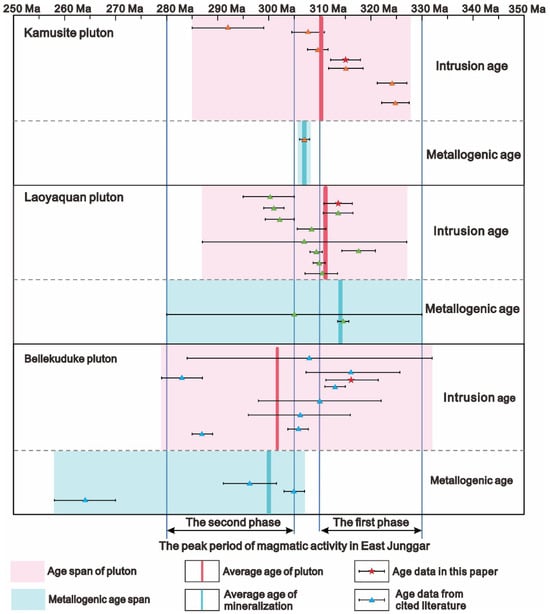
Figure 7.
Comparison of mineralizing age of tin-bearing plutons in the KGB (Kamusite pluton data quoted from [10,19,20,30]; Laoyaquan pluton data quoted from [23,24,25,26,27]; and Beilekuduke pluton data quoted from [27,28,29,30,60]).
6.2. Petrogenesis of the Tin-Bearing Granite
The emplacement relationship between the Kamusite, Laoyaquan, and Beilekuduke plutons in the western KGB is unclear. Different granites in the tin-bearing plutons have similar geochemical characteristics and consistent zircon U-Pb ages (315.1 ± 3.4 Ma, 313.6 ± 2.9 Ma, and 316.5 ± 4.6 Ma, respectively) (Figure 5), indicating a genetic connection due to having been formed by the same magmatic event. Firstly, the features of the above plutons are high SiO2 (SiO2 = 75.53%–77.85%), K2O + Na2O = 8.17%–8.90%, Fe2O3T = 0.90%–1.48%, 10,000×Ga/Al ratios (2.8–4.9), Zr (74.2–177.4 ppm), Hf (4.5–11.8 ppm), Nb (5.80–26.9 ppm), and Sr (3.92–21.5 ppm) contents. The geochemical indicators suggest an A-type granite [61,62,63]. Additionally, The negative Eu anomaly is very strong (δEu = 0.01–0.03) with a V-shaped REE distribution Figure 5a), which is consistent with the geochemical characteristics of A-type granite [61,62,64,65]. In contrast, the FeOT/(FeOT + MgO) ratios of the granites in the Kamusite, Laoyaquan, and Beilekuduke plutons are high (0.89–0.99, 0.87–0.91, and 0.91–0.95, respectively), whereas the FeOT values are 0.86%–1.33%, 0.81%–1.28%, and 0.83%–1.22%, respectively, indicating iron enrichment (0.81%–1.33%) (Figure 3c). Most tin-rich granites are peraluminous, high-potassium, calc-alkaline series granites, which are high in silicon, potassium, aluminum and low in iron, magnesium, and calcium, with negative Eu anomalies [17,39,66,67]. These characteristics are consistent with tin-bearing granites in the western KGB.
As shown in Figure 3c, all samples are ferroan A-type granite, which differs from I-type granite or highly differentiated I-type granite (FeOT < 1.0%) [55,68,69]. In addition, the zircon saturation temperatures (TZr) are 796–836 °C (average 825 °C) for the Kamusite pluton, 776–843 °C (average 796 °C) for the Laoyaquan pluton, and 792–833 °C (average 812 °C) for the Beilekuduke pluton. They are significantly higher than the TZr values of highly fractionated I-type granite (764 °C) [70]. Additionally, the 10,000×Ga/Al and Zr, Nb, Ce, and Y values are critical indicators to distinguish the genetic types of granite [62,69]. The 10,000×Ga/Al versus Zr diagram (Figure 8b) shows that all samples fall into the overlapping area of A-type granite and highly differentiated I,S-type granite, and the trend of the Laoyaquan, Beilekuduke, and Kamusite data (Figure 8b,c) suggest that the Kamusite granites are A-type granites. In the (Zr + Nb + Ce + Y)-(K2O + Na2O)/CaO diagram (Figure 8c), the samples of the Laoyaquan and Beilekuduke plutons are located in different I-type granite areas, whereas the samples of the Kamusite pluton are located in the A-type granite area. Notably, this trend is also observed in the discriminant diagram. Based on zircon trace element analysis, some scholars have suggested these plutons may be I-type granites [44,71,72,73,74]. It is believed that the transition of I- to A-type polygenetic granite is caused by changes in the tectonic setting. Similarly, the zircon Th and Pb concentrations observed in this study show that the three plutons plot into the I-type area and the partially overlapping area of I-type and A-type granite (Figure 8a). This result confirms that the tin-bearing granite may be in the transitional stage of I-type and A-type granite.
Due to the non-uniqueness of extensional tectonic settings, A-type granites can be divided into A1-type granites in non-orogenic settings and A2-type granites in post-collision settings. All samples of the Karamaili tin-bearing pluton are located in the A2-type granite area in the Nb-Y-3Ga triangle diagram (Figure 8d). In summary, these granites are primarily A2-type granites formed in a post-collisional tectonic setting, and the Laoyaquan and Beilekuduke plutons exhibit a transition from I-type to A-type granite (Figure 8a). This phenomenon suggests a tectonic transformation from a compressional to an extensional environment in the KGB [44]. The magmatic evolution of the KGB provides evidence for different tectonic environments. For example, the western KGB consists primarily of tin-containing highly differentiated granite (Figure 9c), whereas the eastern KGB has granite containing mafic microgranular enclaves indicative of magma mixing. In addition, the Kamusite pluton contains subordinate rare water-bearing iron–magnesium minerals, such as sodium iron amphibole [20], suggesting it may have formed in an anhydrous or low-water magmatic environment.
The εHf(t) values of the Kamusite, Laoyaquan, and Beilekuduke plutons are 10.50–17.63, 11.39–16.26, and 10.3–13.8, respectively. They are positive, with low T2DM model age values (670–470 Ma), indicating that the magma source areas of the plutons is juvenile crust [20,23,25]. The whole-rock εNd(t) values range from 3.99 to 5.54, and the T2DM ranges from 616 Ma to 488 Ma (Table 3), suggesting a significant contribution from juvenile crust or partial melting of mantle and subsequent assimilation of crust [13]. This is also basically consistent with the Western Junggar, where the whole-rock εNd(t) values range from 2.29 to 8.75, and the T2DM ranges from 851 Ma to 345 Ma [75]. The significant vertical crustal growth during the late Paleozoic in the Karamaili Tectonic Belt is consistent with the tectonic setting of the KGB A2-type granite having formed in an extensional environment.
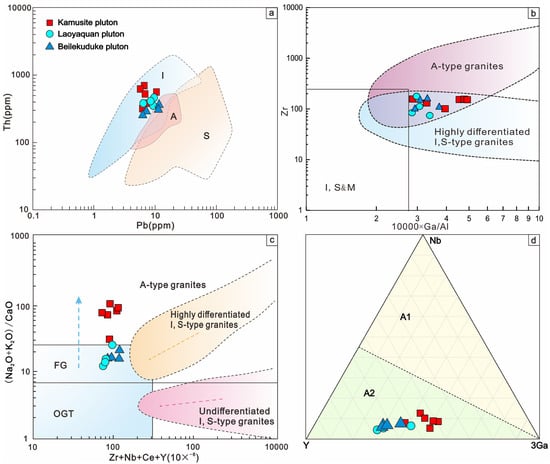
Figure 8.
Granite type discriminant diagram (a–d) ((a) revised from [44]; (b) revised from [62]; (c) revised from [55]; and (d) revised from [76]).
6.3. Tin-Bearing Plutons Under Tectonic Transformation
A-type granite provides significant information for analyzing crustal thinning, accretion, vertical growth, and crust–mantle interaction. The data can be used to determine changes in the tectonic environment and determine the orogenic stage [10,34,65]. The KGB is a NW-trending belt on the Eastern Junggar plate and is parallel to the Karamaili ophiolite belt (Figure 1c), suggesting the dynamic characteristics of intense siliceous magma activity in the extensional environment at the end of continental margin subduction [40,44].
The Karamaili ophiolite at the southern margin of the Eastern Junggar has been dated to the late Silurian–early Carboniferous (417–330 Ma), representing an inter-arc or back-arc ocean basin tectonic setting [12,77,78,79]. The siliceous rocks in the ophiolite belt contain early Carboniferous radiolarian fossils [9,32,77], suggesting residual ocean basins in the early Carboniferous. A large area of Early Carboniferous volcanic rocks is exposed in the south of the Karamaili tectonic belt, and rocks with island arc characteristics are exposed in the north. They may be the product of the bidirectional subduction of the Junggar ocean during this period [9]. In addition, the volcanic rocks of the late Carboniferous Batamayineishan Formation exhibit a bimodal rock assemblage [80], indicating that Eastern Junggar entered the post-collisional stage with an extensional environment in the late Carboniferous (Figure 10). Paleomagnetic data confirm that the Junggar Ocean between the Siberian and Tarim blocks was closed in the late Carboniferous [5].
The tectonic evolution of the Karamaili tectonic belt can be divided into three stages. (1) In the early Devonian–early Carboniferous, the Junggar Ocean converged and contracted, and the ocean crust was subducted northward to the Eastern Junggar arc and southward to the Harlike arc, creating a pre-arc accretional wedge (Figure 11a). The subducting plate released large amounts of melt and fluid, causing partial melting of the overlying mantle wedge and the upwelling of the asthenosphere, resulting in the formation of early Carboniferous volcanic rocks and I-type granites (Figure 11b). (2) In the late Carboniferous, the region entered the post-collisional stage, where the tectonic stress changed from compression to extension. The subducted plate broke off, and the lithosphere was delaminated, causing large-scale crustal thinning and subsequent growth of the juvenile crust. High-temperature magma intruded into the thin part of the continental crust, forming A-type granites, volcanic rocks, and rhyolites. (3) In the early Permian, the continental–continental accretion collision collage and mountain building caused large-scale translational strike-slip movements of micro-blocks along the large fault zone [20,40]. Eastern Junggar was subjected to a strong thrust nappe, resulting in the Ertix strike-slip fault, the Qingshui-Sujiquan fault, and the Karamaili fault. The Laoyaquan and the Beilekuduke plutons were displaced along the NW-trending strike-slip fault, forming the current tectonic pattern of the KGB (Figure 11c). The post-collision stage is an important stage of the orogenic movement. During this period, the detachment of subduction plates, the delamination of the lithosphere, the extension and collapse, and the underplating of magma formed large quantities of granitic rocks, which is consistent covering the KGB A-type granite covering an area of 1100 km2 in the Karamaili tectonic belt [12,20].
Similarly, in the SiO2-Al2O3 and R1-R2 discrimination diagrams, all samples plot into the post-collisional granitic region (Figure 10b), which is consistent with the above results. Notably, in the Rb vs. Yb + Ta and Rb vs. Y + Nb discrimination diagrams (Figure 10c,d), the samples fall near the boundary between intraplate and syn-collisional granites, showing the ambiguity of tectonic setting assignment. However, the Y/Nb ratios are 3.83 to 18.55 (average 9.05), exceeding 1.2 and indicating the samples are post-collisional granites [76]. The likely reason is that the tectonic belt experienced a tectonic transformation period in the late Carboniferous [20,44]. Petrological evidence in the KGB [40] suggests spatial differences between highly fractionated granites in the west and A-type granites with magma mixing in the east because the magmatic effects were caused by different delamination stages. In the late Carboniferous, the Karamaili tectonic belt was in a transition period from a compressional regime at the end of subduction to the post-collision extension environment. The tin-bearing plutons in the western KGB most likely formed in the compressional setting, whereas the plutons in the eastern KGB formed in the extension environment. In addition, it is believed that the Th/U ratio of magmatic zircons formed in the compressional setting of an orogeny is generally less than 1.0, with the data showing little variation [74]. The Th/U ratio of the zircons in our plutons ranges from 0.16 to 0.73, with an average of 0.41, suggesting a compressional setting [74,81]. This is also consistent with the latest view that the western KGB formed in a compressive setting, while the eastern KGB formed in a local extensional setting [44].
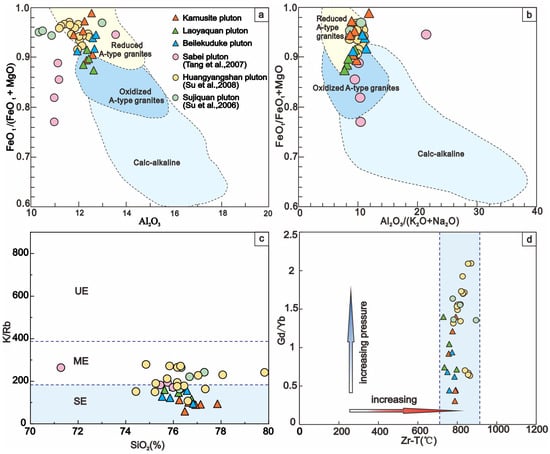
Figure 9.
Illustration of oxidation–reduction, degree of differentiation, and saturation temperature identification of granites of the Casalmelite-bearing rock mass group ((a,b) revised from [21,82]; (c) revised from [21,83]; (d) revised from [8]); and (a–d) data from [21,42,45]).
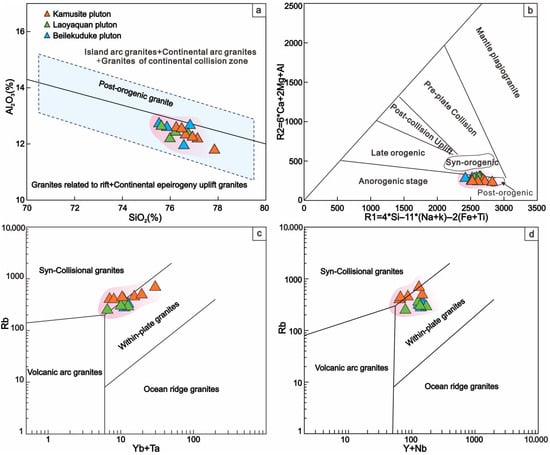
Figure 10.
Tectonic classification diagrams for the tin-bearing granites from Karamaili ((a) revised from [62]; (b) revised from [84]; (c,d) revised from [85]).
6.4. Highly Differentiated Granite and Tin Mineralization
Tin-bearing granites often lack dark minerals. The pale granites and the residual pegmatite veins on the surface suggest that the plutons in the western KGB have undergone strong magmatic differentiation. The Rb/Sr and K/Rb ratios are generally used to determine the magma source area and evolution [20]. Their Rb / Sr ratios will gradually increase when the granitic magma evolves towards higher SiO2 [44,86], and the K/Rb ratio decreases. The samples of the three tin-bearing plutons have high Rb/Sr ratios ranging from 18.47 to 107.35 (average value of 48), and low K/Rb ratios (53.93–169.94) (Figure 9c), indicating they are crust-derived and underwent high differentiation [34]. The SiO2-K/Rb diagram (Figure 9c) shows that the test samples all fall into the SE area, indicating that the tin-bearing plutons underwent strong magmatic evolution, whereas most samples from other plutons in the eastern KGB fall into the ME area. This process differs from that of the Sujiquan, Sabei, and Huangyangshan plutons rich in mafic microgranular enclaves in the eastern KGB, especially the Sabei pluton, which exhibits strong magma mixing. The separation of zirconium minerals (e.g., zircon) decreases the Zr/Hf ratio [86]. The Zr/Hf ratio of all samples in this study is 12.88 to 28.48 (<25), which is lower than the value of undifferentiated granite (Zr/Hf ratio > 55), suggesting again these granites originated from strong magmatic evolution [87].
The granites related to tin mineralization are primarily S-type granites. Tin deposits related to A-type granites have been discovered recently, such as the tin polymetallic deposits in Nigeria’s Jos Plateau [14], the Pitinga tin deposit in Brazil [88], and the Furong super-large tin ore field in Hunan province, China [89]. It is believed that A-type granites in the CAOB are rarely related to tungsten–tin mineralization [90]. However, the alkali-rich, weakly peraluminous A-type granites exposed in the Eastern Junggar are often accompanied by strong Sn mineralization, such as the Kamusite, Ganliangzi, Beilekuduke, and Sareshike tin deposits [40]. High temperatures, extensive differentiation, and a reducing environment are conducive to the differentiation of tin-rich ore-forming fluids, which are the most critical factors affecting tin mineralization [17,40,66,67,91,92]. The zircon saturation temperature of these tin-bearing granites is 768–843 °C (average value of 813 °C) (Figure 9d). All experienced strong crystallization differentiation. Figure 9a,b show that most samples from the plutons fall into the regions of reduced A-type granites, which differs from the Sabei and Sujiquan oxidized granites in the eastern KGB.
Studies on granite mineralization in the Lachlan fold belt in Australia have found that tin-mineralized granites have a low degree of oxidation (Fe2O3/FeO < 1) and a high degree of magma evolution (SiO2 > 70%) [93]. In the SiO2-Fe2O3/FeO and Rb/Sr-Fe2O3/FeO diagrams (Figure 12c,d), most samples of the Kamusite, Laoyaquan, and Beilekuduke plutons in the western KGB fall in the Sn area, whereas those of the Sabei, Huangyangshan, and Sujiquan plutons of the eastern KGB do not occupy this region, indicating that the tin-bearing plutons in the western KGB have relatively low oxidation degrees and high degrees of magmatic evolution. The granite compositions change systematically from the westernmost Kamusite pluton to the east (Figure 12c,d). Similarly, the TiO2-Sn diagram (Figure 12b) indicates that granites from this study fall into the tin-bearing granite area, unlike granites from other parts of the world. The westernmost Kamusite pluton shows more pronounced tin-bearing granite characteristics than the other two plutons (Figure 12b,c), which is consistent with the geological characteristics of the Kamusite pluton because it has the most highly differentiated granites in the KGB. The Rb/Sr-SiO2 diagram (Figure 12a) shows that all samples fall into the region where tin ore and porphyry molybdenum ore overlap, indicating that the Kamusite, Laoyaquan, and Beilekuduke plutons had magmatic conditions conducive to the formation of magmatic–hydrothermal tin–molybdenum deposits (Figure 12a).
The granites in the western KGB have high Sn contents. They are 11.0 × 10−6–25.18 × 10−6 (mean is 16.28 × 10−6), 3.83 × 10−6–14.1 × 10−6 (mean is 8.54 × 10−6), and 13.50 × 10−6–80.0 × 10−6 (mean is 32.38 × 10−6) in the Kamusite, Laoyaquan, and Beilekuduke plutons, respectively. The values are 3–6 times higher than the Clark value of rocks in the Eastern Junggar [20,23,29], indicating that the original magma was rich in tin. In summary, the KGB granite has obvious positive εHf (t) and εNd (t) characteristics (Figure 13a,b), so we believe that, the Eastern Junggar experienced lithospheric delamination at the end of the Late Paleozoic subduction, triggering extensive vertical growth of the juvenile crust. Due to the underplating of the basic magma carrying mantle-derived melt, the area was affected by crustal contamination and strong granitic magmatic activity. The KGB was formed in the late Carboniferous. It may have been affected by delamination stages [40] in the late subduction–post-collision stage. The plutons differ significantly, suggesting a high degree of differentiation and a shallow formation environment in the western KGB. Reducing magmatic conditions occurred, resulting in a transition from highly differentiated I-S-type granite to A-type granite and indicating magmatic conditions suitable for the formation of tin deposits. However, different from the western KGB, the plutons in the eastern KGB have a lower degree of differentiation, and it can be seen from Figure 9d that they are formed in a relatively high-pressure environment. The area is dominated by oxidizing magma conditions and the granites show substantial evidence of magma mixing, such as the presence of dark enclaves. A-type granites are dominant and show metallogenic characteristics closely related to Au and Cu mineralization. The difference in the homologous magma suggests a period of tectonic transformation in the Karamaili region during the late Carboniferous. The compressional setting affected tin mineralization in the western KGB, whereas an extension environment occurred in the eastern KGB [44]. The above-mentioned difference in the granite and mineralization of KGB in the Eastern Junggar suggests the unique subduction mechanism of the Karamaili Ocean. It is worth mentioning that the spatial difference in late Paleozoic granites also exists in Western Junggar. Previous studies have concluded that the zircon high average δ18O values (>6.5‰) of the late Carboniferous granites in the south are caused by the subduction of the ridges in this area and this is obviously different from the Carboniferous–Permian granites with lower zircon δ18O values (<6.5‰) in northern West Junggar [94].

Figure 11.
Pattern of late Paleozoic tectonic evolution in the Eastern Junggar (revised from [9,44,95]).
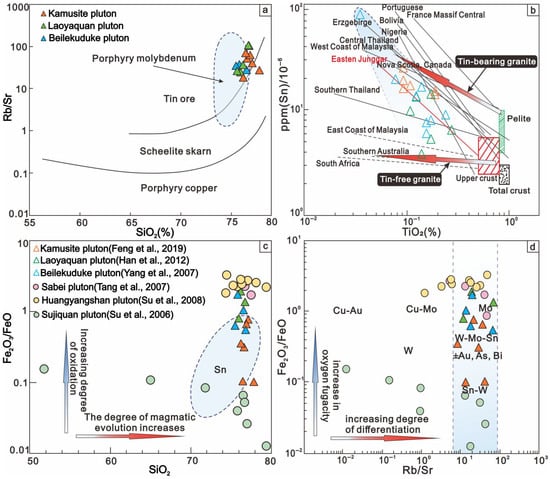
Figure 12.
Granite Rb/Sr-SiO2, granite w(TiO2)-w(Sn), Na + K-Mg-Fe, and Fe2O3-Rb/Sr variations around the world ((a) revised from [83]; (b) revised from Juniper [96]; (c,d) revised from [97]; and (b–d) data from [20,21,23,29,42,45]).
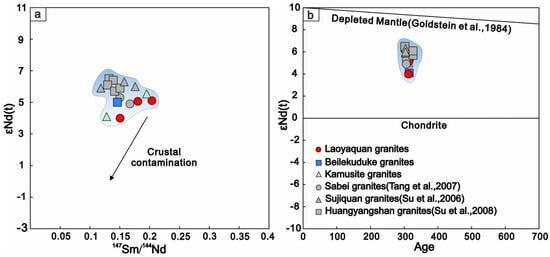
Figure 13.
(a) εNd(t) versus 147Sm/144Nd diagram (revised from [13]); (b) εNd(t) versus age (Ma) (revised from [13]) and (a,b) data from [21,42,45]).
7. Conclusions
(1) The tin-bearing granite in the western KGB has high silicon and potassium contents and low alkali, calcium, and magnesium contents. It is a quasi-aluminous–peraluminous, high-potassium, calc-alkaline granite. A transition occurred in its evolution to I-A type granite. A-type granite is more common in the western part of the KGB.
(2) The diagenetic ages of the Kamusite, Laoyaquan, and Beilekuduke plutons are 315.1 ± 3.4 Ma, 313.6 ± 2.9 Ma, and 316.5 ± 4.6 Ma, respectively. The plutons formed in the early–late Carboniferous. The diagenetic ages are consistent with the tin mineralization ages.
(3) The tin-bearing plutons formed under low-pressure, high-temperature, and reducing magmatic conditions, resulting in significant differentiation. The whole-rock Nd isotope analysis shows that the magma source is dominated by juvenile crust from the mantle.
(4) The KGB formed during the transition period of tectonic transformation from the late subduction stage to the post-collision stage. Compression affected the tin-bearing plutons in the western section, and extension influenced the low-tin-content plutons in the eastern section.
Author Contributions
Conceptualization, S.Y. and B.Z.; methodology, Q.W. and C.S.; software, C.S.; validation, S.Y. and B.Z.; formal analysis, Q.W. and C.S.; investigation, S.Y., B.Z., C.S. and Q.W.; resources, B.Z. and X.G.; data curation, S.Y.; writing—original draft preparation, S.Y. and B.Z.; writing—review and editing, B.Z., C.S. and Q.W.; visualization, C.S.; supervision, B.Z. and Q.W.; project administration, B.Z.; funding acquisition, B.Z. All authors have read and agreed to the published version of the manuscript.
Funding
This study was financially supported by the Natural Science Foundation of Xinjiang Uygur Autonomous Region (2021D01C042).
Data Availability Statement
All relevant data are within the paper.
Acknowledgments
We would like to thank Jiangang Ding from Zijin Mining Group Northwest Co. Ltd. for his valuable discussions and constructive feedback on improving this paper. We also extend our gratitude to the anonymous reviewers for their careful review of the manuscript and their constructive comments and editing suggestions.
Conflicts of Interest
Author Qiwei Wang was employed by the company Yumen Oilfield. The remaining authors declare that the research was conducted in the absence of any commercial or financial relationships that could be construed as a potential conflict of interest.
References
- Şengör, A.M.C.; Natal’in, B.A.; Burtman, V.S. Evolution of the Altaid tectonic collage and Palaeozoic crustal growth in Eurasia. Nature 1993, 364, 299–307. [Google Scholar] [CrossRef]
- Windley, B.F.; Alexeiev, D.; Xiao, W.; Kröner, A.; Badarch, G. Tectonic models for accretion of the Central Asian Orogenic Belt. J. Geol. Soc. 2007, 164, 31–47. [Google Scholar] [CrossRef]
- Xiao, W.; Windley, B.F.; Han, C.; Liu, W.; Wan, B.; Zhang, J.E.; Ao, S.; Zhang, Z.; Song, D. Late Paleozoic to early Triassic multiple roll-back and oroclinal bending of the Mongolia collage in Central Asia. Earth-Sci. Rev. 2018, 186, 94–128. [Google Scholar] [CrossRef]
- Xiao, W.J.; Zhang, L.C.; Qin, K.Z.; Sun, S.; Li, J.L. Paleozoic accretionary and collisional tectonics of the Eastern Tianshan (China): Implications for the continental growth of central Asia. Am. J. Sci. 2004, 304, 370–395. [Google Scholar] [CrossRef]
- Xu, X.-W.; Jiang, N.; Li, X.-H.; Wu, C.; Qu, X.; Zhou, G.; Dong, L.-H. Spatial–temporal framework for the closure of the Junggar Ocean in central Asia: New SIMS zircon U–Pb ages of the ophiolitic mélange and collisional igneous rocks in the Zhifang area, East Junggar. J. Asian Earth Sci. 2015, 111, 470–491. [Google Scholar] [CrossRef]
- Windley, B.F.; Xiao, W. Ridge subduction and slab windows in the Central Asian Orogenic Belt: Tectonic implications for the evolution of an accretionary orogen. Gondwana Res. 2018, 61, 73–87. [Google Scholar] [CrossRef]
- Zheng, R.; Xiao, W.; Li, J.; Wu, T.; Zhang, W. A Silurian-early Devonian slab window in the southern Central Asian Orogenic Belt: Evidence from high-Mg diorites, adakites and granitoids in the western Central Beishan region, NW China. J. Asian Earth Sci. 2018, 153, 75–99. [Google Scholar] [CrossRef]
- Zhu, K.-Y.; Li, Z.-X.; Xu, X.-S.; Wilde, S.A.; Chen, H.-L. Early Mesozoic ferroan (A-type) and magnesian granitoids in eastern South China: Tracing the influence of flat-slab subduction at the western Pacific margin. Lithos 2016, 240–243, 371–381. [Google Scholar] [CrossRef]
- Su, Y.; Zeng, J.; Ping, X.; Liang, L.; Wang, J. Magmatism and Tectonic Evolution Since Late Paleozoic in the Junggar Area, Northern Xinjiang. Ph.D. Thesis, China University of Geosciences, Wuhan, China, 2018. (In Chinese with English Abstract). [Google Scholar]
- Han, B.; Ji, J.; Song, B.; Chen, L.; Zhang, L. Late Paleozoic vertical growth of continental crust around the Junggar Basin, Xinjiang, China (Part I): Timing of post-collisional plutonism. Acta Petrol. Sin. 2006, 5, 1077–1086, (In Chinese with English Abstract). [Google Scholar]
- Wu, F.; Li, X.; Yang, J.; Zheng, Y. Discussions on the petrogenesis of granites. Acta Petrol. Sin. 2007, 6, 1217–1238, (In Chinese with English Abstract). [Google Scholar]
- Xiao, W.; Han, C.; Yuan, C.; Chen, H.; Sun, M.; Lin, S.; Li, Z.; Mao, Q.; Zhang, J.; Sun, S.; et al. Unique Carboniferous-Permian tectonic-metallogenic framework of Northern Xinjiang (NW China): Constraints for the tectonics of the southern Paleoasian Domain. Acta Petrol. Sin. 2006, 22, 1062–1076, (In Chinese with English Abstract). [Google Scholar]
- Wang, T.; Hou, Z. Isotopic mapping and deep material probing (I): Revealing the compositional evolution of the lithosphere and crustal growth processes. Geosci. Front. 2018, 25, 1–19. [Google Scholar]
- Ohmoto, H. Metal deposits in relation to plate tectonics. Earth-Sci. Rev. 1990, 22, 258–259. [Google Scholar] [CrossRef]
- Mao, J.; Xie, G.; Guo, C.; Chen, Y. Large-scale tungsten-tin mineralization in the Nanling region, South China: Metallogenic ages and corresponding geodynamic processes. Acta Petrol. Sin. 2007, 10, 2329–2338, (In Chinese with English Abstract). [Google Scholar]
- Bi, C.; Shen, X.; Xu, Q. The Geological features and Origin of the Beilekuduk Tin Metallogenic Belt. Bull. Chin. Acad. Geol. Sci. 1994, 29, 56–71, (In Chinese with English Abstract). [Google Scholar]
- Chen, Y. The Geological Features and Wall-Rock Alteration of the Tin Deposit Related to A-Type Granite from Kalamaili, North Xinjiang. Master’s Thesis, Granting China University of Geosciences (Beijing), Beijing, China, 2013. (In Chinese with English Abstract). [Google Scholar]
- Wang, L.; Wang, J.; Wang, Y.; Long, L.; Tang, P. Laoyaquan alkaline rock and related tin deposits in eastern Junggar, Xinjiang. Acta Mineral. Sin. 2011, 27, 1485–1492, (In Chinese with English Abstract). [Google Scholar]
- Wu, W.; Liao, Q.; Chen, S.; Hu, C.; Tian, J.; Wang, F.; Fan, G. Petrogenesis and geological significance of highly fractionated A-type granites in Kalasayi, East Junggar. Geol. Bull. China 2015, 34, 385–399, (In Chinese with English Abstract). [Google Scholar]
- Feng, H.; Zhang, B.; Gao, D.; Zhan, X.; Zheng, Y. Geochronology, Geochemical Characteristics and Tectonic Setting of the Kamusite A2-Type Granite in the Eastern Junggar. Bull. Mineral. Petrol. Geochem. 2019, 38, 1154–1169. (In Chinese) [Google Scholar]
- Tang, H.; Su, Y.; Qiu, H.; Han, Y. 40Ar-39Ar age of tin mineralization in Beilekuduke tin ore belt, East Junggar, Xinjiang. Acta Petrol. Sin. 2009, 25, 1303–1309, (In Chinese with English Abstract). [Google Scholar]
- Zhao, D.; Yang, J.; Hu, N.; Xu, A. Isotopic Geochronological Characteristics of the Laoyaquan Stanniferous Granite in Eastern Junggar Basin in Xinjiang. J. Earth Sci. Environ. 2000, 2, 15–17, (In Chinese with English Abstract). [Google Scholar]
- Han, Y.; Tang, H.; Gan, L. Zircon U-Pb Ages and Geochemical Characteristics of the Laoyaquan A-type Granites in East Junggar, North Xinjiang, China. Acta Mineral. Sin. 2012, 32, 193–199, (In Chinese with English Abstract). [Google Scholar]
- Hu, W. Geochemical Characteristics and Geological Significance of Late Carboniferous Granites from the Laoyaquan in Eastern Junggar, Xinjiang. Master’s Thesis, Granting Lanzhou University, Lanzhou, China, 2016. (In Chinese with English Abstract). [Google Scholar]
- Youlituzi, T. Petrogenesis of the Laoyaquan Pluton in East Junggar, Xinjiang and Their Geological Significance. Master’s Thesis, Granting Xinjiang University, Urumqi, China, 2020. (In Chinese with English Abstract). [Google Scholar]
- Chen, F.; Li, H.; Cai, H.; Liu, G.; Chang, H. Chronology and Origin of the Ganliangzi Tin Orefield, Xinjiang. Miner. Depos. 1999, 1, 94–100. [Google Scholar]
- Tang, H.; Qu, W.; Su, Y.; Hou, G.; Du, A.; Cong, S. Genetic connection of Sareshike tin deposit with the alkaline A-type granites of Sabei body in Xinjiang: Constraint from isotopic ages. Acta Petrol. Sin. 2007, 23, 989–997, (In Chinese with English Abstract). [Google Scholar]
- Li, Y.; Yang, F.; Zhao, c.; Zhang, Y.; Yan, S. SHRIMP U-Pb zircon dating of the Beilekuduk pluton in Xinjiang and its geological implications. Acta Petrol. Sin. 2007, 23, 1–6, (In Chinese with English Abstract). [Google Scholar]
- Gaoxue, Y.; Yongjun, L.; GuoHui, S.; Hongen, W.; Zhao, J. LA-ICP-MS Zircon U-Pb Age, Geochemistry and Genesis of the Aluminous A-type Granite in Beilekuduke, Xinjiang. Acta Geol. Sin. 2010, 84, 11, (In Chinese with English Abstract). [Google Scholar]
- Tang, H.; Chen, Y.; Liu, Y.; Huang, B. Isotope Dating of the Be’erkuduke Tin Deposit in the Eastern Junggar Area. Mineral. Petrol. 2006, 2, 71–73. [Google Scholar]
- Liu, X.; Xiao, W.; Xiao, Y.; Liu, P.; Song, Y.; Huang, W.; Zhang, Z.; Liu, X. Major Characteristics of the Ridge Subduction in the Central Asian Orogenic Belt and Their Research Advances. Geochimica 2025, 54, 3–23. [Google Scholar]
- Li, J. Early Paleozoic Evolution of Lithosphere Plate, East Junggar, Xinjiang. Bull. Chin. Acad. Geol. Sci. 1991, 2, 1–12, (In Chinese with English Abstract). [Google Scholar]
- Xiao, W.; Han, C.; Yuan, C.; Sun, M.; Lin, S.; Chen, H.; Li, Z.; Li, J.; Sun, S. Middle Cambrian to Permian subduction-related accretionary orogenesis of Northern Xinjiang, NW China: Implications for the tectonic evolution of central Asia. J. Asian Earth Sci. 2008, 32, 102–117. [Google Scholar] [CrossRef]
- Wang, T.; Huang, H.; Song, P.; Wu, H.; Zhang, J. Studies of Crustal Growth and Deep Lithospheric Architecture and New Issues: Exemplified by the Central Asian Orogenic Belt (Northern Xinjiang). Geoscience 2020, 45, 2326–2344. [Google Scholar]
- Liu, X.; Xu, J.; Castillo, P.R.; Xiao, W.; Shi, Y.; Feng, Z.; Guo, L. The Dupal isotopic anomaly in the southern Paleo-Asian Ocean: Nd–Pb isotope evidence from ophiolites in Northwest China. Lithos 2014, 189, 185–200. [Google Scholar] [CrossRef]
- Liu, X.; Xu, J.; Xiao, W.; Castillo, P.R.; Shi, Y.; Wang, S.; Huo, Q.; Feng, Z. The boundary between the Central Asian Orogenic belt and Tethyan tectonic domain deduced from Pb isotopic data. J. Asian Earth Sci. 2015, 113, 7–15. [Google Scholar] [CrossRef]
- Geng, Y.; Liu, Z.; Huang, S.; He, Z. Geochronology and geochemistry of Kalamaili granitic rocks and uranium ore-forming potential at the northeastern margin of Junggar Basin, China. J. Earth Sci. Environ. 2022, 44, 20–41, (In Chinese with English Abstract). [Google Scholar]
- Yang, G.; Li, Y.; Wu, H.; Zhong, X.; Yang, B.; Yan, C.; Yan, J.; Si, G. Geochronological and geochemical constrains on petrogenesis of the Huangyangshan A-type granite from the East Junggar, Xinjiang, NW China. J. Asian Earth Sci. 2011, 40, 722–736. [Google Scholar] [CrossRef]
- Sun, Z.; Liu, G.; Ren, Y.; Chen, X.; Sun, X.; Wang, C.; Li, Z. Age, Genesis and Tectonic Setting of the Sayashk Tin Deposit in the East Junggar Region: Constraints from Lu–Hf Isotopes, Zircon U–Pb and Molybdenite Re–Os Dating. Minerals 2022, 12, 1063. [Google Scholar] [CrossRef]
- Zhang, B.; Chen, C.; Gong, X.; Yalikun, Y.; Kaheman, K. The Kamusite A2-type granites in the Karamaili tectonic belt, Xinjiang (NW China): Tracing staged postcollisional delamination in the eastern Junggar. Geol. Mag. 2020, 158, 723–748. [Google Scholar] [CrossRef]
- Liu, X.; Castillo, P.; Jifeng, X.; Hou, Q. Geochemistry and rock association in the Karamaili Paleo-Asian ophiolite in east Junggar, NW China suggest ridge-trench interaction. Geochim. Et Cosmochim. Acta 2009, 73, 73. [Google Scholar]
- Su, Y.; Tang, H.; Cong, F. Zircon U-Pb age and Petrogenesis of the Huangyangshan Alkaline granite Body in East Junggar, Xinjiang. Acta Mineral. Sin. 2008, 2, 117–126, (In Chinese with English Abstract). [Google Scholar]
- Yang, G.; Li, Y.; Si, G.; Wu, H.; Zhang, Y.; Jin, z. Petrological Characteristic of the Huangyangshan Intrusion in Kalamaili Area, East Junggar, Xinjiang. J. Earth Sci. Environ. 2009, 31, 34–41, (In Chinese with English Abstract). [Google Scholar]
- Wang, Q.; Bowen, Z.; Jiangang, D.; Xinzhong, Z.; Yaxiaer, Y.; Mayila, A.; Xiang, W.; Yacong, W.; Haowei, P.; Yafei, S.; et al. Origin of the late Carboniferous Karamaili Granite Belt in Eastern Junggar, Northwest China: Zircon U-Pb and trace element constraints. Int. Geol. Rev. 2025, 67, 166–183. [Google Scholar] [CrossRef]
- Yuping, S.; Hongfeng, T.; Congqiang, L.; Guangshun, H.; Lili, L. The determination and a preliminary study of Sujiquan aluminous A-type granites in East Junggar, Xinjiang. Acta Petrol. Et Mineral. 2006, 25, 175–184, (In Chinese with English Abstract). [Google Scholar]
- Zhang, D.; Zhao, K.-D.; Wang, B.-D.; Cheng, K.-D.; Luo, X.-L.; Zhang, W.; Li, Q.; Jiang, S.-Y. Cretaceous granitic magmatism and mineralization in the Shanhu W-Sn ore deposit in the Nanling Range in South China. Ore Geol. Rev. 2020, 126, 103758. [Google Scholar] [CrossRef]
- Sun, X. Magmatism, Mineralization and Ore-prospecting Direction of the Huangyangshan Super-Large Graphite Deposit in Qitai County, Xinjiang. Master’s Thesis, Granting Jilin University, Jilin, China, 2022. (In Chinese with English Abstract). [Google Scholar]
- Feng, H. A Study on the Vertical Growth Mechanism of Late Palaeozoic Continental Crust in the Eastern Precambrian Margin: A Case Study of the Kalamaili Granite Belt. Master’s Thesis, Granting Xinjiang University, Urumqi, China, 2021. (In Chinese with English Abstract). [Google Scholar]
- Zhang, W.; Hu, Z.; Liu, Y. Iso-Compass: New freeware software for isotopic data reduction of LA-MC-ICP-MS. J. Anal. At. Spectrom. 2020, 35, 1087–1096. [Google Scholar] [CrossRef]
- Li, J.; Tang, S.; Zhu, X.; Pan, C. Production and Certification of the Reference MaterialGSB 04-3258-2015 as a 143Nd/144Nd Isotope Ratio Reference. Geostand. Geoanalytical Res. 2017, 41, 255–266. [Google Scholar] [CrossRef]
- Watson, E.B.; Harrison, T.M. Zircon saturation revisited: Temperature and composition effects in a variety of crustal magma types. Earth Planet. Sci. Lett. 1983, 64, 295–304. [Google Scholar] [CrossRef]
- Miller, C.F.; McDowell, S.M.; Mapes, R.W. Hot and cold granites? Implications of zircon saturation temperatures and preservation of inheritance. Geology 2003, 31, 529–532. [Google Scholar] [CrossRef]
- Middlemost, E.A.K. Naming materials in the magma/igneous rock system. Earth-Sci. Rev. 1994, 37, 215–224. [Google Scholar] [CrossRef]
- Rickwood, P.C. Boundary lines within petrologic diagrams which use oxides of major and minor elements. Lithos 1989, 22, 247–263. [Google Scholar] [CrossRef]
- Frost, B.R.; Barnes, C.G.; Collins, W.J.; Arculus, R.J.; Ellis, D.J.; Frost, C.D. A Geochemical Classification for Granitic Rocks. J. Petrol. 2001, 42, 2033–2048. [Google Scholar] [CrossRef]
- MANIAR, P.D.; PICCOLI, P.M. Tectonic discrimination of granitoids. GSA Bull. 1989, 101, 635–643. [Google Scholar] [CrossRef]
- Sun, S.; McDonough, W.F.; McDonough, W.F. Chemical and isotopic systematics of oceanic basalts: Implications for mantle composition and processes. Geol. Soc. Spec. Publ. 1989, 42, 313–345. [Google Scholar] [CrossRef]
- DePaolo, D.J. Neodymium isotopes in the Colorado Front Range and crust–mantle evolution in the Proterozoic. Nature 1981, 291, 193–196. [Google Scholar] [CrossRef]
- Jacobsen, S.B.; Wasserburg, G.J. Sm-Nd isotopic evolution of chondrites. Earth Planet. Sci. Lett. 1980, 50, 139–155. [Google Scholar] [CrossRef]
- Liu, J.; Yuan, K. A Discussion on the Genesis and Tectonic Setting of Alkali Granites in the Ulungur Alkali-Rich Granite Belt, Xinjiang. Geol. J. China Univ. 1996, 2, 257–272, (In Chinese with English Abstract). [Google Scholar]
- Collins, W.J.; Beams, S.D.; White, A.J.R.; Chappell, B.W. Nature and origin of A-type granites with particular reference to southeastern Australia. Contrib. Mineral. Petrol. 1982, 80, 189–200. [Google Scholar] [CrossRef]
- Whalen, J.; Currie, K.; Chappell, B. A-type granites: Geochemical characteristics, discrimination and petrogenesis. Contrib. Mineral. Petrol. 1987, 95, 407–419. [Google Scholar] [CrossRef]
- Schmitt, A.K.; Emmermann, R.; Trumbull, R.B.; BÜHn, B.; Henjes-Kunst, F. Petrogenesis and 40Ar/39Ar Geochronology of the Brandberg Complex, Namibia: Evidence for a Major Mantle Contribution in Metaluminous and Peralkaline Granites. J. Petrol. 2000, 41, 1207–1239. [Google Scholar] [CrossRef]
- Jackson, N.J.; Walsh, J.N.; Pegram, E. Geology, geochemistry and petrogenesis of late Precambrian granitoids in the Central Hijaz Region of the Arabian Shield. Contrib. Mineral. Petrol. 1984, 87, 205–219. [Google Scholar] [CrossRef]
- Zhang, Q. Geodynamic implications of continental granites. Acta Petrol. Et Mineral. 2014, 33, 785–798, (In Chinese with English Abstract). [Google Scholar]
- Jiang, S.; Zhao, K.; Jiang, H.; Su, H.; Xiong, S. Spatiotemporal distribution, geological characteristics and metallogenic mechanism of tungsten and tin deposits in China: An overview. Chin. Sci. Bull. 2020, 65, 3730–3745, (In Chinese with English Abstract). [Google Scholar]
- Zhou, Z.; Mao, J. Metallogenic patterns and ore deposit model of the tin polymetallic deposits in the southern segment of Great Xing’an Range. Earth Sci. Front. 2022, 29, 176–199. [Google Scholar]
- White, A.J.R.; Clemens, J.D.; Holloway, J.R.; Silver, L.T.; Chappell, B.W.; Wall, V.J. S-type granites and their probable absence in southwestern North America. Geology 1986, 14, 115–118. [Google Scholar] [CrossRef]
- Eby, G.N. The A-type granitoids: A review of their occurrence and chemical characteristics and speculations on their petrogenesis. Lithos 1990, 26, 115–134. [Google Scholar] [CrossRef]
- King, P.L.; White, A.J.R.; Chappell, B.W.; Allen, C.M. Characterization and Origin of Aluminous A-type Granites from the Lachlan Fold Belt, Southeastern Australia. J. Petrol. 1997, 38, 371–391. [Google Scholar] [CrossRef]
- Kemp, A.I.S.; Hawkesworth, C.J.; Paterson, B.A.; Kinny, P.D. Episodic growth of the Gondwana supercontinent from hafnium and oxygen isotopes in zircon. Nature 2006, 439, 580–583. [Google Scholar] [CrossRef]
- Kirkland, C.; Whitehouse, M.; Slagstad, T. Fluid-assisted zircon and monazite growth within a shear zone: A case study from Finnmark, Arctic Norway. Contrib. Mineral. Petrol. 2009, 158, 637–657. [Google Scholar] [CrossRef]
- Kirkland, C.L.; Smithies, R.H.; Taylor, R.J.M.; Evans, N.; McDonald, B. Zircon Th/U ratios in magmatic environs. Lithos 2015, 212–215, 397–414. [Google Scholar] [CrossRef]
- McKay, M.P.; Jackson, W.T.; Hessler, A.M. Tectonic stress regime recorded by zircon Th/U. Gondwana Res. 2018, 57, 1–9. [Google Scholar] [CrossRef]
- Xu, S.; Ding, W.; Chen, X.; Li, Y.; Han, L.; Liu, Y.; Ma, F.; Wang, Y. Late Paleozoic crustal composition and growth in West Junggar: Evidence from Sr-Nd-Pb isotopic mapping. Earth Sci. Front. 2022, 29, 261–280. [Google Scholar]
- Eby, G.N. Chemical subdivision of the A-type granitoids:Petrogenetic and tectonic implications. Geology 1992, 20, 641–644. [Google Scholar] [CrossRef]
- Shu, L.; Wang, Y. Late Devonian-Early Carboniferous Radiolarian Fossils from Siliceous Rocks of the Kelameili Ophiolite, Xinjiang. Geol. Rev. 2003, 49, 408–412. [Google Scholar]
- Jian, P.; Liu, D.; Zhang, Q.; Zhang, F.; Shi, Y.; Shi, G.; Zhang, L.; Tao, H. SHRIMP Dating of Ophiolite and Leucocratic Rocks within Ophiolite. Earth Sci. Front. 2003, 4, 439–456. [Google Scholar]
- Wang, B. Study of Karamaili Ophiolite Complex and Jiangbasitao Formation Volcanic Rocks in East Junggar of Xinjiang. Master’s Thesis, Granting Chang’an University, Xi’an, China, 2009. (In Chinese with English Abstract). [Google Scholar]
- Yang, K.; Bian, W.; Wang, Q.; Wang, P.; Lang, J. Zircon U-Pb age and its geological significance of the igneous rocks from Batamayineishan Formation in East Junggar. Acta Petrol. Sin. 2018, 34, 3341–3358, (In Chinese with English Abstract). [Google Scholar]
- Xie, W.; Lu, Y.; Chen, L.-M.; Song, X.-Y.; Deng, Y.-F.; Zhao, Y. Zircon Th/U ratios suggest a post-collision extensional setting for the Permian Ni-Cu sulfide deposits in the Eastern Tianshan, NW China. Ore Geol. Rev. 2022, 144, 104837. [Google Scholar] [CrossRef]
- Dall’Agnol, R.; de Oliveira, D.C. Oxidized, magnetite-series, rapakivi-type granites of Carajás, Brazil: Implications for classification and petrogenesis of A-type granites. Lithos 2007, 93, 215–233. [Google Scholar] [CrossRef]
- BLEVIN, P.L. Redox and Compositional Parameters for Interpreting the Granitoid Metallogeny of Eastern Australia: Implications for Gold-rich Ore Systems. Resour. Geol. 2004, 54, 241–252. [Google Scholar] [CrossRef]
- Batchelor, R.A.; Bowden, P. Petrogenetic interpretation of granitoid rock series using multicationic parameters. Chem. Geol. 1985, 48, 43–55. [Google Scholar] [CrossRef]
- Pearce, J.A.; Harris, N.B.W.; Tindle, A.G. Trace Element Discrimination Diagrams for the Tectonic Interpretation of Granitic Rocks. Jour Pet. 1984, 25, 956–983. [Google Scholar] [CrossRef]
- Guo, C.; Zeng, L.; Gao, L.; Su, H.; Ma, X. Highly Fractionated Granitic Minerals and Whole-rock Geochemistry Prospecting Markers in Hetian, Fujian Province. Acta Geol. Sin. 2017, 8, 1796–1817, (In Chinese with English Abstract). [Google Scholar]
- Breiter, K.; Lamarão, C.N.; Borges, R.M.K.; Dall’Agnol, R. Chemical characteristics of zircon from A-type granites and comparison to zircon of S-type granites. Lithos 2014, 192–195, 208–225. [Google Scholar] [CrossRef]
- Lenharo, S.L.R.; Pollard, P.J.; Born, H. Petrology and textural evolution of granites associated with tin and rare-metals mineralization at the Pitinga mine, Amazonas, Brazil. Lithos 2003, 66, 37–61. [Google Scholar] [CrossRef]
- Zhao, Z.; Bao, Z.; Zhang, B.; Xiong, X. Crust-mantle interaction and its contribution to the Shizhuyuan superlarge tungsten polymetallic mineralization. Sci. China Ser. D Earth Sci. 2001, 44, 266–276. [Google Scholar] [CrossRef]
- Zhang, Q.; Ran, H.; Li, C. A-type granite: What is the essence? Acta Petrol. Et Mineral. 2012, 31, 621–626, (In Chinese with English Abstract). [Google Scholar]
- Zheng, W.; Mao, J.-W.; Zhao, H.-J.; Ouyang, H.-G.; Zhao, C.-S.; Yu, X.-F. Geochemistry, Sr–Nd–Pb–Hf isotopes systematics and geochronological constrains on petrogenesis of the Xishan A-type granite and associated W–Sn mineralization in Guangdong Province, South China. Ore Geol. Rev. 2017, 88, 739–752. [Google Scholar] [CrossRef]
- Zhu, J.; Tan, S.; Yang, J.; He, X.; Zhang, S.; Liu, Z.; Wang, Y. What controls Sn-W mineralization in granite batholith: A case study from the world-class Dulong Sn-Zn polymetallic ore deposit of SW China. Ore Geol. Rev. 2024, 166, 105968. [Google Scholar] [CrossRef]
- Blevin, P.L.; Chappell, B.W. The role of magma sources, oxidation states and fractionation in determining the granite metallogeny of eastern Australia. Trans. R. Soc. Edinb. Earth Sci. 1992, 83, 305–316. [Google Scholar]
- Yin, J.; Xiao, W.; Wang, T.; Fowler, M.; Kerr, A.C.; Sun, M.; Strachan, R.; Huang, H.; Zhang, J.e.; Chen, W.; et al. Maturation from oceanic arcs to continental crust: Insights from Paleozoic magmatism in West Junggar, NW China. Earth-Sci. Rev. 2024, 253, 104795. [Google Scholar] [CrossRef]
- Li, Z.; Nie, F.; Tian, X.; Shi, Y.; Niu, H. Redefinition of Formation Age of Late Paleozoic Strata in the Eastern Junggar Tectonic Zone and its Implications for Evolution of Regional Geological Structure. Acta Geol. Sin. 2016, 90, 569–588, (In Chinese with English Abstract). [Google Scholar]
- Juniper, D.N.; Kleeman, J.D. Geochemical characterization of some tin-mineralizing granites of New South Wales. J. Geochem. Explor. 1979, 11, 321–333. [Google Scholar] [CrossRef]
- Lehmann, B.; Harmanto. Large-scale tin depletion in the Tanjungpandan tin granite, Belitung Island, Indonesia. Econ. Geol. 1990, 85, 99–111. [Google Scholar] [CrossRef]
Disclaimer/Publisher’s Note: The statements, opinions and data contained in all publications are solely those of the individual author(s) and contributor(s) and not of MDPI and/or the editor(s). MDPI and/or the editor(s) disclaim responsibility for any injury to people or property resulting from any ideas, methods, instructions or products referred to in the content. |
© 2025 by the authors. Licensee MDPI, Basel, Switzerland. This article is an open access article distributed under the terms and conditions of the Creative Commons Attribution (CC BY) license (https://creativecommons.org/licenses/by/4.0/).